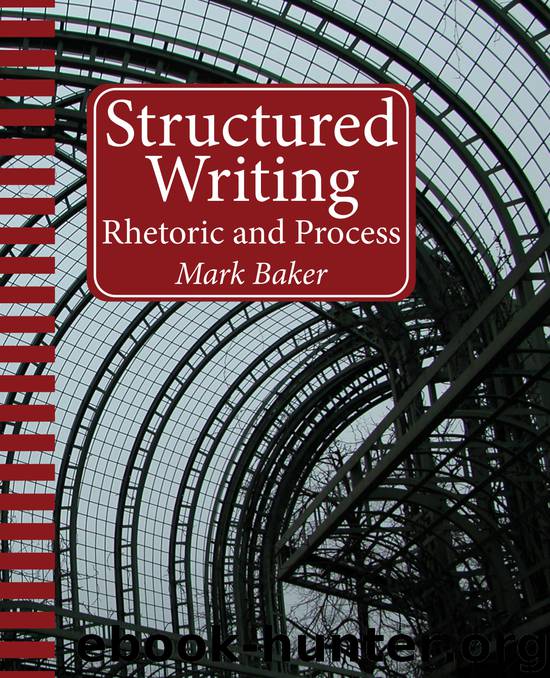Structured Writing by Mark Baker

Author:Mark Baker
Language: eng
Format: epub
Tags: technical writing, desktop publishing, documentation, electronic publishing, document management
ISBN: 9781937434571
Publisher: XML Press
Published: 2018-10-31T16:00:00+00:00
But do these values represent the size of the graphic or the size at which is it to be displayed in a particular medium? In other words, do they tell a processor the size of the image itself or do they describe the size of the box (viewport) the image should fit in?[35]
DocBook allows you to make this distinction. Its imagedata tag supports attributes for specifying the size of the viewport (height and width) and the size of the image (contentheight and contentwidth). The specification also contains additional attributes related to scaling and alignment and complex rules about how the rendering algorithm is supposed to behave based on which combination of these attributes you specify.[36] In other words, DocBook contains a sophisticated language to describe the sizing and scaling of graphics. It not only deals with media-domain properties, it actually gives media-domain instructions.
Of course, working in the media domain can cause problems. It interferes with functional lucidity and makes differential single sourcing more difficult. But there is another issue to consider. In addition to needing different scaling values for different output media, sometimes the best approach to differential single sourcing is to use different versions of the same graphic for different media. For instance, you may want to use a vector format for print and a raster format for online media.
For all these reasons, we need to distinguish the source of an image from the rendering of that image. For raster images, the source is the original high-resolution file recorded by a camera, a screen shot, or a raster file produced by an image editing program. For vector graphics, it is the original vector drawing file. From these source images, you can render a wide range of images.
What if you need a vector version for some media and a raster version for others? One approach is to generate a raster version of the appropriate size from the vector version. This can be done at build time, but most of the time you store multiple versions and select the right one to publish. To create the best image in each format, the artist may even create several renderings of the same image idea, optimizing each for different uses. For instance, you may need a separate gray-scale version of your company logo, because the automatic gray-scale rendering of a color logo may not look good. You may also want to use different resolutions of the same raster graphic for different media or for different purposes. And you may want to manually redraw a graphic at different resolutions to add or remove detail, rather than simply scaling it mechanically.
In these cases, how do you include the image in your source content? You can’t simply include the source file and scale it, since there are now several source files. You have to go back to the idea of the image – the image that was in the artist’s head – rather than any of the individual renderings of that image. How do you do that?
In DocBook you can use conditional processing, as shown in see Figure 23.
Download
This site does not store any files on its server. We only index and link to content provided by other sites. Please contact the content providers to delete copyright contents if any and email us, we'll remove relevant links or contents immediately.
Asking the Right Questions: A Guide to Critical Thinking by M. Neil Browne & Stuart M. Keeley(5356)
Autoboyography by Christina Lauren(5086)
Dialogue by Robert McKee(4160)
Eat That Frog! by Brian Tracy(4149)
Sticky Fingers by Joe Hagan(3911)
Journeys Out of the Body by Robert Monroe(3460)
Annapurna by Maurice Herzog(3298)
Full Circle by Michael Palin(3268)
Elements of Style 2017 by Richard De A'Morelli(3235)
Schaum's Quick Guide to Writing Great Short Stories by Margaret Lucke(3187)
The Art of Dramatic Writing: Its Basis in the Creative Interpretation of Human Motives by Egri Lajos(2857)
The Diviners by Libba Bray(2800)
Why I Write by George Orwell(2773)
The Mental Game of Writing: How to Overcome Obstacles, Stay Creative and Productive, and Free Your Mind for Success by James Scott Bell(2766)
In Patagonia by Bruce Chatwin(2755)
Atlas Obscura by Joshua Foer(2705)
The Fight by Norman Mailer(2700)
Venice by Jan Morris(2430)
The Elements of Style by William Strunk and E. B. White(2376)
